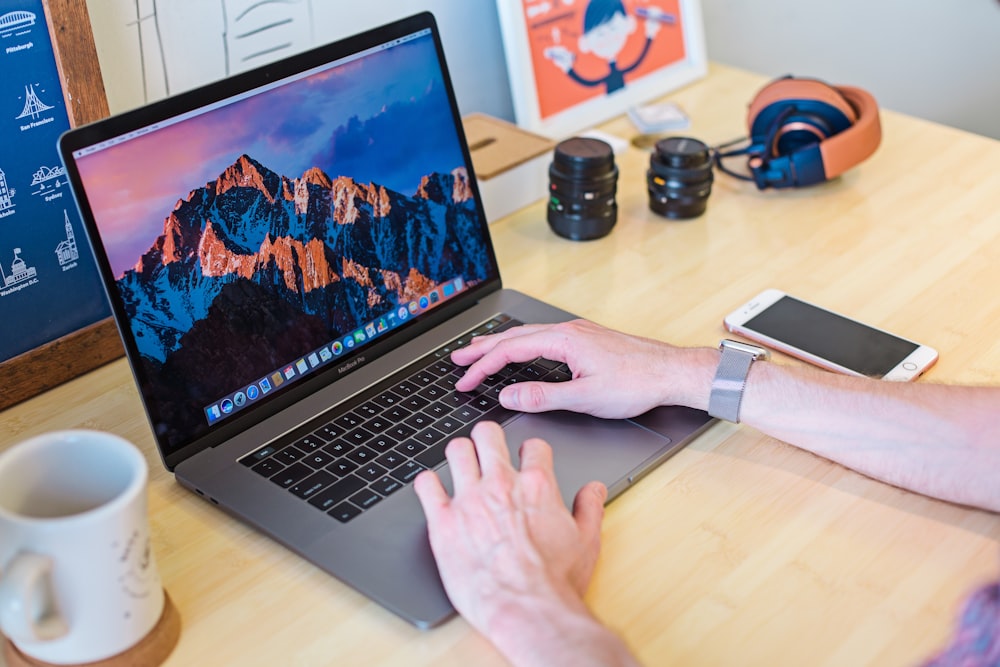Apple’s MacBook line of laptops are a very popular choice for both everyday users and enthusiasts that want a bit more power out of their portable device. They’re light, they’re powerful, and they seem to last a lifetime if you take care of them. Unless, of course, your device happens to be plagued by something like a pink screen.
The MacBook pink screen issue has been around for a few years, with various reasons for your MacBook screen to turn pink and become unresponsive. It can be a software issue, in which case you can try and fix the pink screen of death yourself, or it can be a hardware issue, in which case an Apple repair center is your best bet.
How To Fix MacBook Pro Pink Screen
With that in mind, if you’ve got the pink screen of death on your MacBook, there are a few things you can do to try to fix it. First – disconnect any hubs or external devices that may be causing the issue. If that doesn’t help, you’ll need to identify whether you’ve got a hardware or software issue, and take it from there.
Quick note – I always recommend backing up your data if possible before attempting any of the below steps. This can be as simple as making a copy of your most important files to a USB disk, or performing a Time Machine backup.
Step 1: Determine If You Have a Hardware or Software Issue
The pink screen appeared first in the 2016 MacBooks, and became popular under the name Flexgate. In Apple’s pursuit to create a laptop that’s as thin as possible, they shipped a series of MacBooks with thin display ribbon cables that weren’t as durable as the company thought. The cables were a part of the hinge and subject to constant flexing, which wore them out and damaged them. The result? The pink screen of death.

To see if this is the reason behind your problem, you can try connecting an external display to your device. If you still have a pink screen on the external display as well, it’s probably caused by a software issue, rather than the display ribbon cable being damaged.
If the external display works fine, it may be a hardware issue with your device, and you may need to take your device to an Apple store or an authorized service provider.
Step 2: Restart Your MacBook
If you still have the pink screen even on an external display, the issue is very likely to be software related. You could try restarting your device, and see if that fixes the issue.
The problem is sometimes caused by malfunctioning GPU drivers, in which case a reboot after disconnecting any recently plugged-in external devices will reload those drivers and may fix the issue. If not, here are a few more troubleshooting steps.
Step 3: Update to the Latest macOS Version
The MacBook pink screen can occur on both Intel-based Macs and occasionally Apple silicon MacBooks running macOS Big Sur 11.2 to 11.4. So, the first thing you want to do is update your software. At the time of writing, the latest macOS version is macOS Ventura, 13.0.1.
To update your Mac, click the Apple menu button in the top left-hand corner of your screen. Then, click “About this Mac” and click “Software Update”.
If you are unable to access your operating system at all due to pink screen, you can try updating it from safe mode.
There are two ways to get into safe mode, depending on whether you’ve got an Intel-based device, or an Apple M1/M2 device. First things first, in both cases, turn off your device.
For Intel-based devices:
- Press the power button and hold down the Shift key until the Apple logo appears.
- Then, release the Shift key and wait for your device to boot up. Once it boots, head to the App Store, find the latest version of macOS and download it in Safe Mode.
For Apple Silicon devices:
- Press and hold the power button until the startup options appear.
- Then, choose your startup disk, press and hold the Shift key and click Continue in Safe Mode.
- Release the Shift key and wait for the device to boot up. Then, try to update again.
Once the install is done, see if it fixed your MacBook pink screen. Now is also a good time to upgrade your MacBook’s operating system to the latest version of macOS. At the time of this video, it is macOS Ventura.

Step 4: Uninstall Incompatible Software
Third party software can cause issues with your device, so before you try some of the other troubleshooting steps, try to remember if you’ve recently installed new software before you started getting the pink screen issue. If you have, uninstall the third party software, or if you have a Time Machine backup, use it to go back to before you installed the software.
Uninstalling incompatible third party software is the last thing you can try before we move on to slightly more complex solutions to the pink screen issue.
Step 5: Reset the System Management Controller
The SMC (short for System Management Controller) is responsible for managing functions like power, sleep, fan speed and keyboard back-lights. It’s also responsible for something called video mode switching. It may be the cause for your MacBook screen going pink, and resetting it may fix the issue.
Keep in mind that this solution only applies if you have an Intel-based device – Apple silicon Macs reset their SMC every time they are restarted. If you have an Apple silicon Mac – skip to step 7.
To reset the SMC on Intel-based Macs:
- Turn off your device and disconnect the charging cable.
- Hold Shift, Option and Control, and then press and hold the power button. Hold all the keys pressed for 10 seconds, then release them.
- Connect the charging cable and turn on your device.
Step 6: Reset the NVRAM
The NVRAM, or the non-volatile RAM, is a memory partition that stores data even when your device is turned off. One of the things it stores is the screen resolution, and a glitch in the saved settings may cause a pink screen. There is no way to reset the NVRAM on Apple Silicon devices, but here are the steps for Intel-based devices.
- Turn off your device.
- Press down and hold Option, Command, P and R, and turn on your device. Hold the keys combination until you hear the second startup sound, then release the buttons.
- If you have a device with a T2 security chip, release the buttons after the Apple logo appears and disappears the second time.
Step 7: Disable Automatic Graphics Switching
The automatic graphics switching option changes which graphics processing unit your laptop uses when you have both a dedicated graphics card, and an integrated graphics card in order to provide better battery life. One of the causes for a pink screen is a glitch in the switching process, so disabling it may fix the MacBook pink screen issue on your device.
- Boot your device into Safe Mode (use the instructions in the OS update section).
- Click the Apple logo and choose System Preferences.
- Go to the Battery tab and uncheck Automatic graphics switching.
Alternatively, you could try the macOS Recovery Mode and the Terminal to do the same thing.
- For Intel-based devices, click the Apple logo and select Restart. Immediately press and hold Command and R, and wait until your Mac boots into macOS Recovery Mode. For Apple Silicon devices, turn off your device. Press and hold the power button until the startup options menu appears. Click the gear icon labeled Options, and click Continue – now you’re in macOS Recovery Mode.
- Choose Utilities, and then Terminal from the menu bar.
- Type the following command in the Terminal window and execute it by pressing the Return key: nvram fa4ce28d-b62f-4c99-9cc3-6815686e30f9:gpu-power-prefs=%01%00%00%00
Step 8: Reinstall macOS
As a last resort before you send your device to an Apple store or repair center, you could try reinstalling macOS. Keep in mind that reinstalling your operating system won’t remove any of your data, so it’s less destructive than you may think.
To reinstall macOS, use the steps from the previous solution to get into your device’s recovery mode. To start the installation, choose “Reinstall macOS” from the recovery menu, and follow the on-screen instructions.

If Nothing Works
It’s probably worth taking your device to an authorized service provider. If there’s any issue with your screen display or any other kind of hardware failure, an authorized service provider should be able to diagnose it and tell you how much it would cost to fix.
Wrapping Things Up
To sum things up, if your MacBook Pro screen (or MacBook Air, for that matter) is permanently pink, and no amount of tinkering with software fixes the issue, it’s very likely to be hardware related. It may be the display ribbon cable, or a faulty graphics card, but it’s usually an issue that requires an authorized technician to fix.
If the troubleshooting tips outlined above did fix the issue, it might’ve been kernel panic or a temporary bug. While in most cases, this is nothing to worry about, if it continues happening it might indicate there is a more serious issue going on. If this is the case, you should take your MacBook to an authorized service and have it looked at for any hardware issues.
Pro tip: if your MacBook is no longer covered under it’s manufacturer’s warranty (usually 12 months) check and see if it’s potentially covered under consumer law.
MacBook Pink Screen FAQ
Why Does My MacBook Screen Turn Pink?
The pink screen of death might be caused by either a software issue, such as a kernel panic, a display resolution issue or a software incompatibility with an app you might have installed. Alternatively, it may be a hardware problem with the display cable that connects your screen to your device’s motherboard.
How To Fix MacBook Pro Pink Screen?
If your MacBook Pro pink screen issue stems from a software incompatibility, you could try updating your operating system, resetting the SMC and NVRAM, or disabling the GPU switching. If it’s a hardware problem such as the display ribbon cable, the pink screen issue can be fixed by taking your device to an authorized service center
How To Reset SMC on a MacBook?
One way to potentially fix MacBook pink screen is by resetting the SMC on your MacBook. If you have an Apple silicon device, the SMC resets automatically each time you restart. If you have an Intel-based MacBook, you can follow the steps outlined in Apple’s support article.





